Hikma Pharmaceuticals: Stakeholder, Funding, and Value Creation Report
VerifiedAdded on 2020/03/04
|20
|3490
|111
Report
AI Summary
This report provides a comprehensive analysis of Hikma Pharmaceuticals, focusing on stakeholder management, funding strategies, and value creation. It begins with an introduction to Hikma, a multinational pharmaceutical company, and then explores value creation using the balance scorecard, examining financial, customer, internal business process, and learning and growth perspectives. The report then applies Mendelow's Matrix to identify key stakeholders and their influence. A financial analysis, including ratio analysis and debt financing options, is presented. Finally, the report utilizes the EVA model to assess the value created by the organization, including calculations of CAPM, WACC, and EVA, providing a detailed evaluation of Hikma's financial performance and stakeholder engagement.

Running head: STAKEHOLDER, FUNDING AND VALUE
Stakeholder, funding and value
Name of the student
Name of the university
Author note
Stakeholder, funding and value
Name of the student
Name of the university
Author note
Paraphrase This Document
Need a fresh take? Get an instant paraphrase of this document with our AI Paraphraser
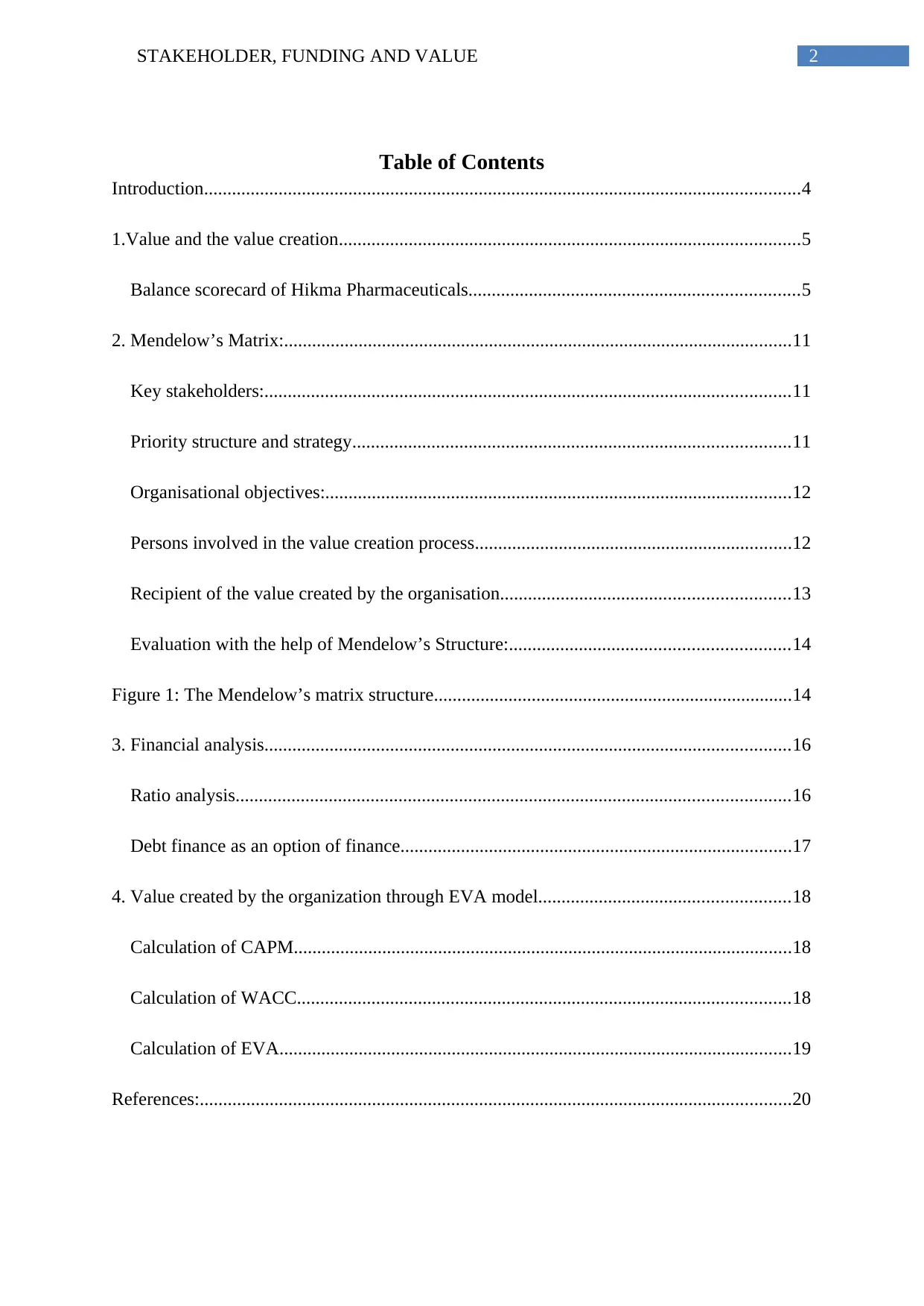
2STAKEHOLDER, FUNDING AND VALUE
Table of Contents
Introduction................................................................................................................................4
1.Value and the value creation...................................................................................................5
Balance scorecard of Hikma Pharmaceuticals.......................................................................5
2. Mendelow’s Matrix:.............................................................................................................11
Key stakeholders:.................................................................................................................11
Priority structure and strategy..............................................................................................11
Organisational objectives:....................................................................................................12
Persons involved in the value creation process....................................................................12
Recipient of the value created by the organisation..............................................................13
Evaluation with the help of Mendelow’s Structure:............................................................14
Figure 1: The Mendelow’s matrix structure.............................................................................14
3. Financial analysis.................................................................................................................16
Ratio analysis.......................................................................................................................16
Debt finance as an option of finance....................................................................................17
4. Value created by the organization through EVA model......................................................18
Calculation of CAPM...........................................................................................................18
Calculation of WACC..........................................................................................................18
Calculation of EVA..............................................................................................................19
References:...............................................................................................................................20
Table of Contents
Introduction................................................................................................................................4
1.Value and the value creation...................................................................................................5
Balance scorecard of Hikma Pharmaceuticals.......................................................................5
2. Mendelow’s Matrix:.............................................................................................................11
Key stakeholders:.................................................................................................................11
Priority structure and strategy..............................................................................................11
Organisational objectives:....................................................................................................12
Persons involved in the value creation process....................................................................12
Recipient of the value created by the organisation..............................................................13
Evaluation with the help of Mendelow’s Structure:............................................................14
Figure 1: The Mendelow’s matrix structure.............................................................................14
3. Financial analysis.................................................................................................................16
Ratio analysis.......................................................................................................................16
Debt finance as an option of finance....................................................................................17
4. Value created by the organization through EVA model......................................................18
Calculation of CAPM...........................................................................................................18
Calculation of WACC..........................................................................................................18
Calculation of EVA..............................................................................................................19
References:...............................................................................................................................20
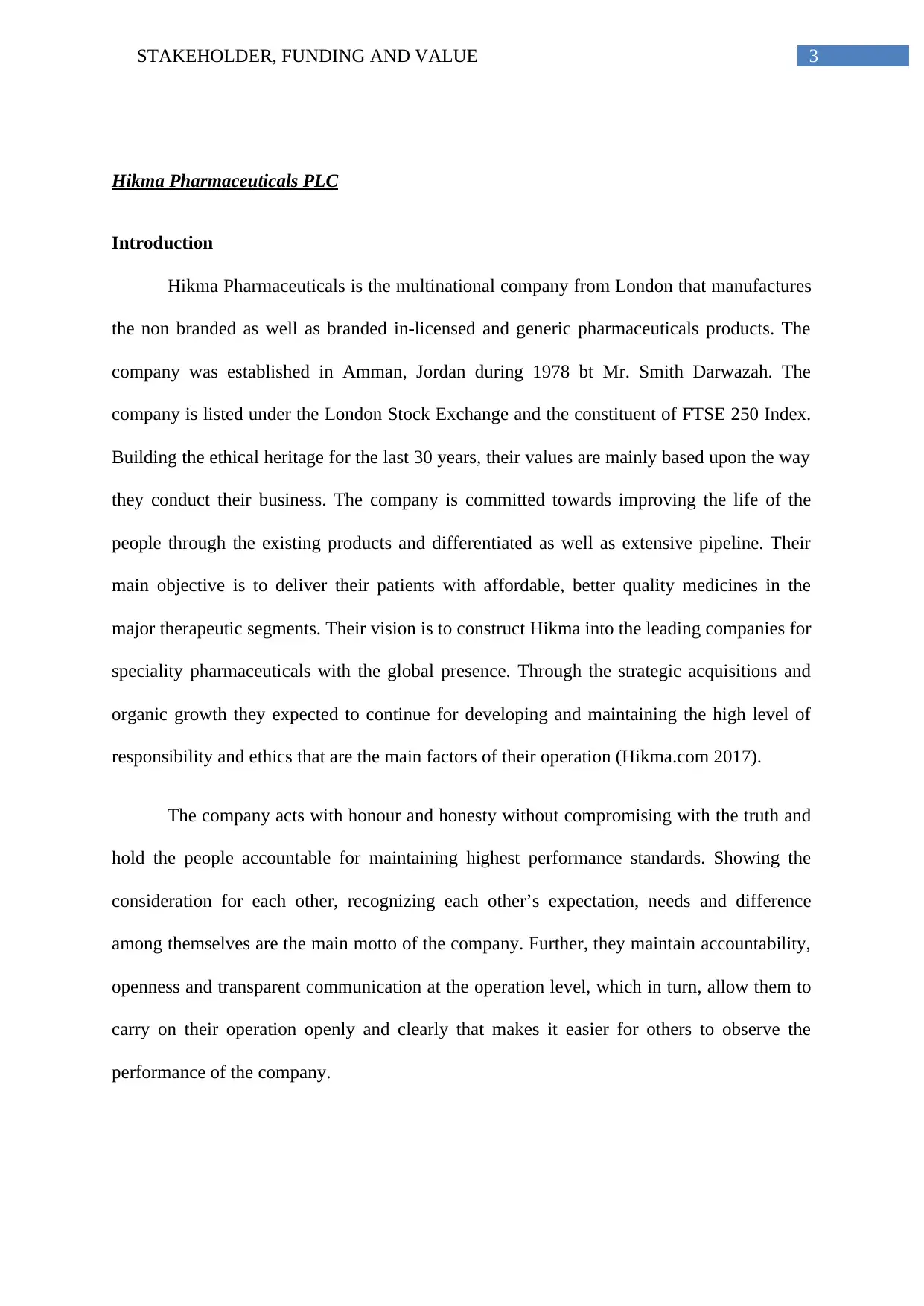
3STAKEHOLDER, FUNDING AND VALUE
Hikma Pharmaceuticals PLC
Introduction
Hikma Pharmaceuticals is the multinational company from London that manufactures
the non branded as well as branded in-licensed and generic pharmaceuticals products. The
company was established in Amman, Jordan during 1978 bt Mr. Smith Darwazah. The
company is listed under the London Stock Exchange and the constituent of FTSE 250 Index.
Building the ethical heritage for the last 30 years, their values are mainly based upon the way
they conduct their business. The company is committed towards improving the life of the
people through the existing products and differentiated as well as extensive pipeline. Their
main objective is to deliver their patients with affordable, better quality medicines in the
major therapeutic segments. Their vision is to construct Hikma into the leading companies for
speciality pharmaceuticals with the global presence. Through the strategic acquisitions and
organic growth they expected to continue for developing and maintaining the high level of
responsibility and ethics that are the main factors of their operation (Hikma.com 2017).
The company acts with honour and honesty without compromising with the truth and
hold the people accountable for maintaining highest performance standards. Showing the
consideration for each other, recognizing each other’s expectation, needs and difference
among themselves are the main motto of the company. Further, they maintain accountability,
openness and transparent communication at the operation level, which in turn, allow them to
carry on their operation openly and clearly that makes it easier for others to observe the
performance of the company.
Hikma Pharmaceuticals PLC
Introduction
Hikma Pharmaceuticals is the multinational company from London that manufactures
the non branded as well as branded in-licensed and generic pharmaceuticals products. The
company was established in Amman, Jordan during 1978 bt Mr. Smith Darwazah. The
company is listed under the London Stock Exchange and the constituent of FTSE 250 Index.
Building the ethical heritage for the last 30 years, their values are mainly based upon the way
they conduct their business. The company is committed towards improving the life of the
people through the existing products and differentiated as well as extensive pipeline. Their
main objective is to deliver their patients with affordable, better quality medicines in the
major therapeutic segments. Their vision is to construct Hikma into the leading companies for
speciality pharmaceuticals with the global presence. Through the strategic acquisitions and
organic growth they expected to continue for developing and maintaining the high level of
responsibility and ethics that are the main factors of their operation (Hikma.com 2017).
The company acts with honour and honesty without compromising with the truth and
hold the people accountable for maintaining highest performance standards. Showing the
consideration for each other, recognizing each other’s expectation, needs and difference
among themselves are the main motto of the company. Further, they maintain accountability,
openness and transparent communication at the operation level, which in turn, allow them to
carry on their operation openly and clearly that makes it easier for others to observe the
performance of the company.
⊘ This is a preview!⊘
Do you want full access?
Subscribe today to unlock all pages.

Trusted by 1+ million students worldwide
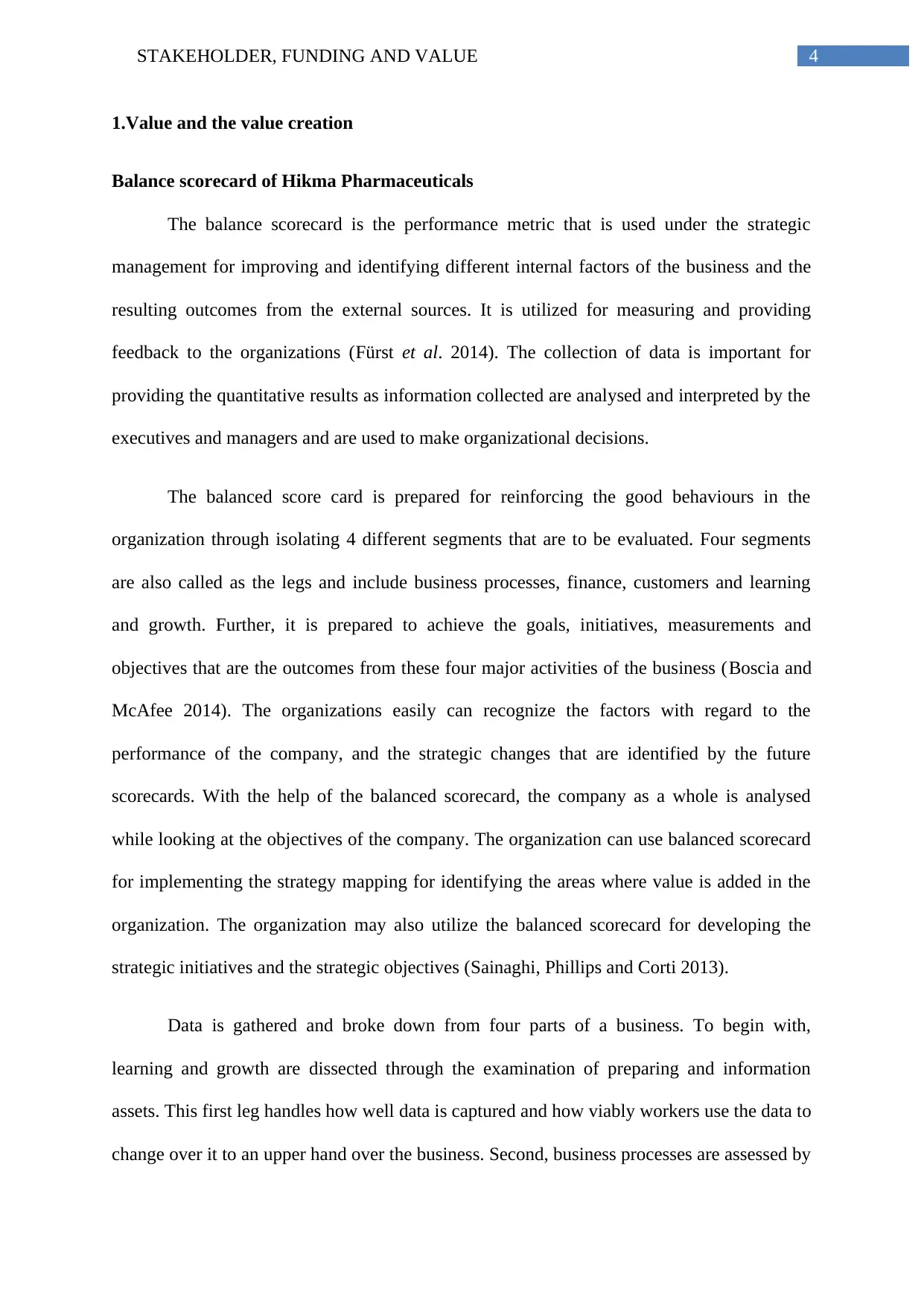
4STAKEHOLDER, FUNDING AND VALUE
1.Value and the value creation
Balance scorecard of Hikma Pharmaceuticals
The balance scorecard is the performance metric that is used under the strategic
management for improving and identifying different internal factors of the business and the
resulting outcomes from the external sources. It is utilized for measuring and providing
feedback to the organizations (Fürst et al. 2014). The collection of data is important for
providing the quantitative results as information collected are analysed and interpreted by the
executives and managers and are used to make organizational decisions.
The balanced score card is prepared for reinforcing the good behaviours in the
organization through isolating 4 different segments that are to be evaluated. Four segments
are also called as the legs and include business processes, finance, customers and learning
and growth. Further, it is prepared to achieve the goals, initiatives, measurements and
objectives that are the outcomes from these four major activities of the business (Boscia and
McAfee 2014). The organizations easily can recognize the factors with regard to the
performance of the company, and the strategic changes that are identified by the future
scorecards. With the help of the balanced scorecard, the company as a whole is analysed
while looking at the objectives of the company. The organization can use balanced scorecard
for implementing the strategy mapping for identifying the areas where value is added in the
organization. The organization may also utilize the balanced scorecard for developing the
strategic initiatives and the strategic objectives (Sainaghi, Phillips and Corti 2013).
Data is gathered and broke down from four parts of a business. To begin with,
learning and growth are dissected through the examination of preparing and information
assets. This first leg handles how well data is captured and how viably workers use the data to
change over it to an upper hand over the business. Second, business processes are assessed by
1.Value and the value creation
Balance scorecard of Hikma Pharmaceuticals
The balance scorecard is the performance metric that is used under the strategic
management for improving and identifying different internal factors of the business and the
resulting outcomes from the external sources. It is utilized for measuring and providing
feedback to the organizations (Fürst et al. 2014). The collection of data is important for
providing the quantitative results as information collected are analysed and interpreted by the
executives and managers and are used to make organizational decisions.
The balanced score card is prepared for reinforcing the good behaviours in the
organization through isolating 4 different segments that are to be evaluated. Four segments
are also called as the legs and include business processes, finance, customers and learning
and growth. Further, it is prepared to achieve the goals, initiatives, measurements and
objectives that are the outcomes from these four major activities of the business (Boscia and
McAfee 2014). The organizations easily can recognize the factors with regard to the
performance of the company, and the strategic changes that are identified by the future
scorecards. With the help of the balanced scorecard, the company as a whole is analysed
while looking at the objectives of the company. The organization can use balanced scorecard
for implementing the strategy mapping for identifying the areas where value is added in the
organization. The organization may also utilize the balanced scorecard for developing the
strategic initiatives and the strategic objectives (Sainaghi, Phillips and Corti 2013).
Data is gathered and broke down from four parts of a business. To begin with,
learning and growth are dissected through the examination of preparing and information
assets. This first leg handles how well data is captured and how viably workers use the data to
change over it to an upper hand over the business. Second, business processes are assessed by
Paraphrase This Document
Need a fresh take? Get an instant paraphrase of this document with our AI Paraphraser
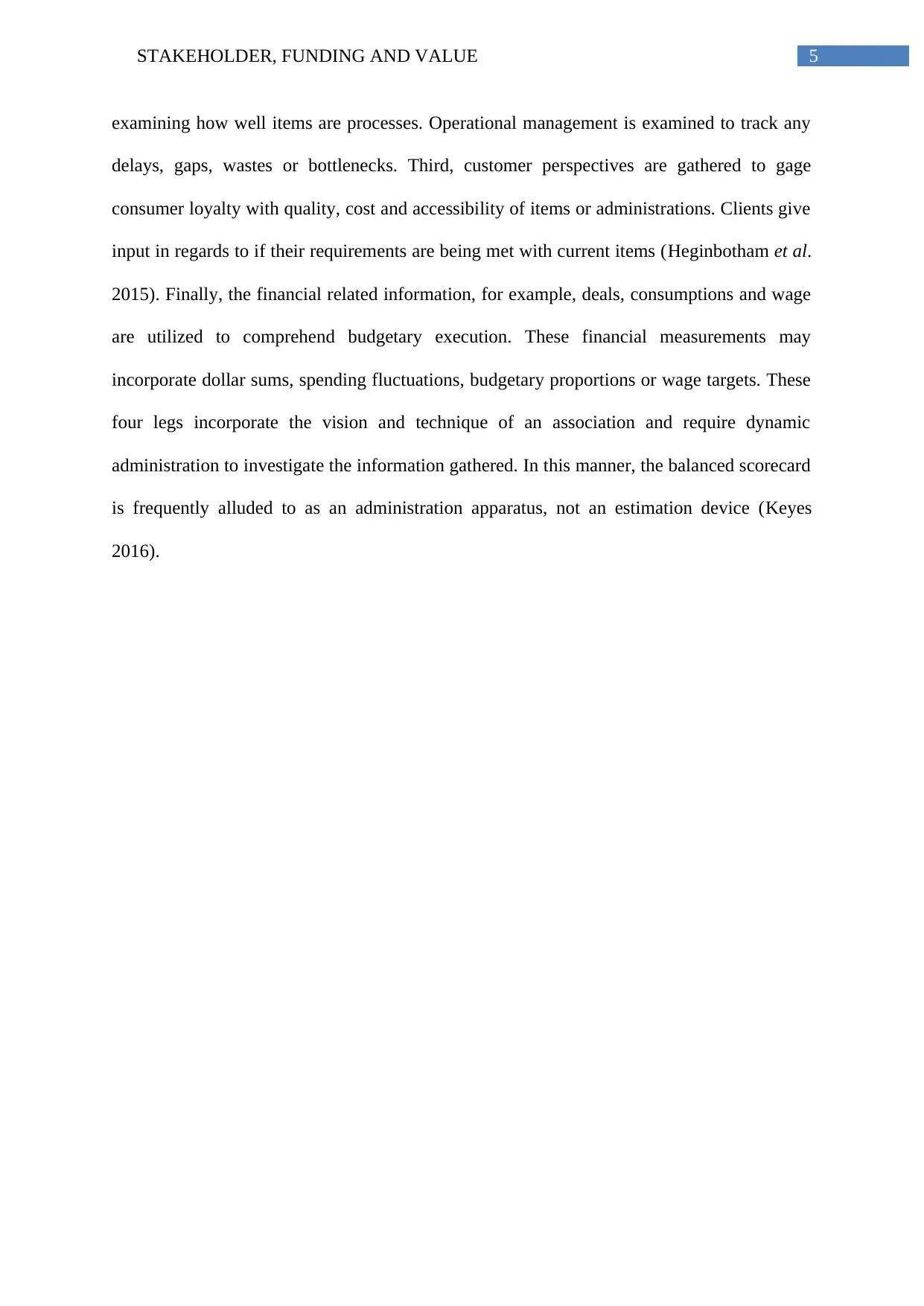
5STAKEHOLDER, FUNDING AND VALUE
examining how well items are processes. Operational management is examined to track any
delays, gaps, wastes or bottlenecks. Third, customer perspectives are gathered to gage
consumer loyalty with quality, cost and accessibility of items or administrations. Clients give
input in regards to if their requirements are being met with current items (Heginbotham et al.
2015). Finally, the financial related information, for example, deals, consumptions and wage
are utilized to comprehend budgetary execution. These financial measurements may
incorporate dollar sums, spending fluctuations, budgetary proportions or wage targets. These
four legs incorporate the vision and technique of an association and require dynamic
administration to investigate the information gathered. In this manner, the balanced scorecard
is frequently alluded to as an administration apparatus, not an estimation device (Keyes
2016).
examining how well items are processes. Operational management is examined to track any
delays, gaps, wastes or bottlenecks. Third, customer perspectives are gathered to gage
consumer loyalty with quality, cost and accessibility of items or administrations. Clients give
input in regards to if their requirements are being met with current items (Heginbotham et al.
2015). Finally, the financial related information, for example, deals, consumptions and wage
are utilized to comprehend budgetary execution. These financial measurements may
incorporate dollar sums, spending fluctuations, budgetary proportions or wage targets. These
four legs incorporate the vision and technique of an association and require dynamic
administration to investigate the information gathered. In this manner, the balanced scorecard
is frequently alluded to as an administration apparatus, not an estimation device (Keyes
2016).
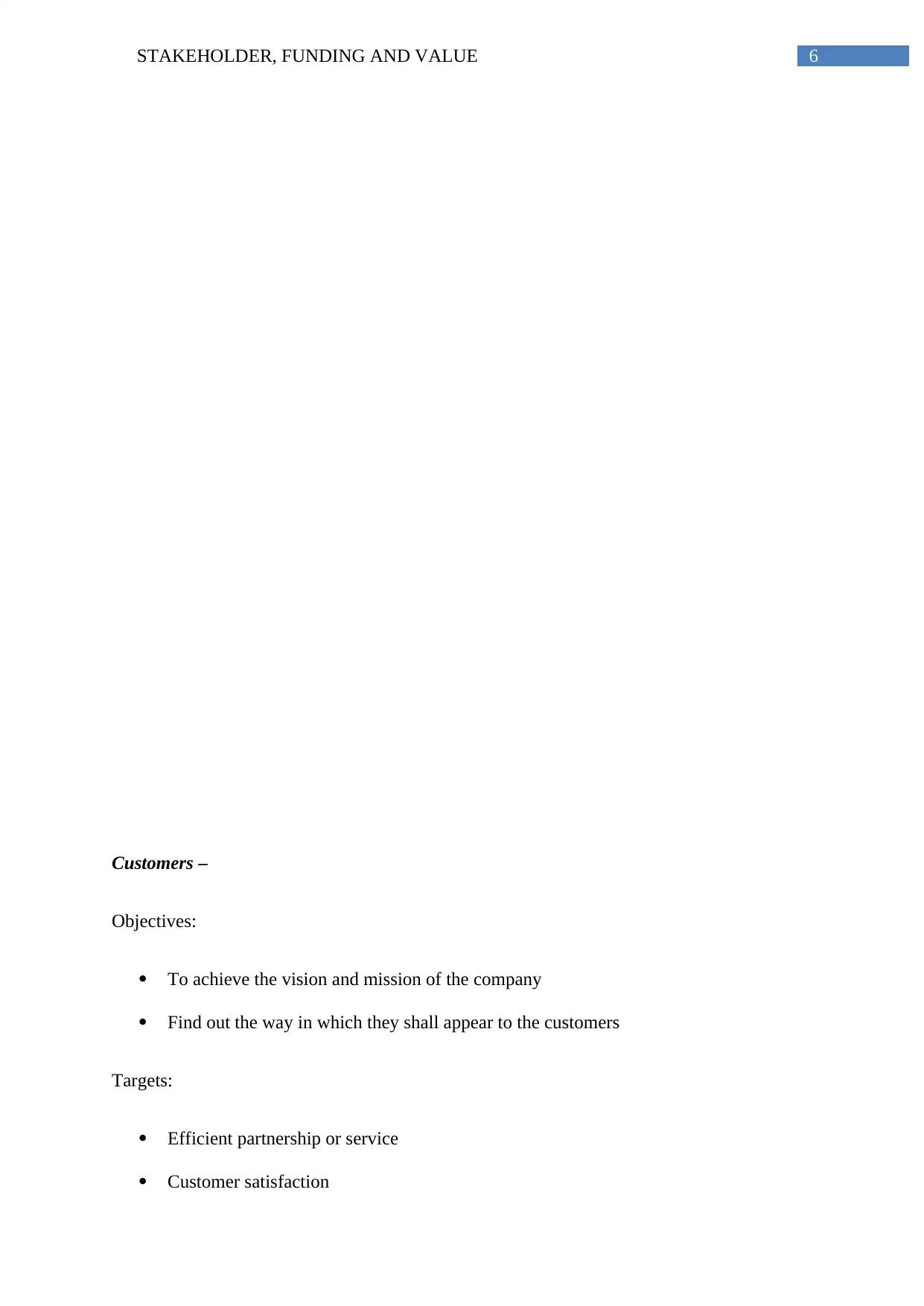
6STAKEHOLDER, FUNDING AND VALUE
Customers –
Objectives:
To achieve the vision and mission of the company
Find out the way in which they shall appear to the customers
Targets:
Efficient partnership or service
Customer satisfaction
FinancialObjectiveTargetsMeasuresInitiativesBusienessProcessesObjectiveTargetsMeasuresInitiatives
Customers –
Objectives:
To achieve the vision and mission of the company
Find out the way in which they shall appear to the customers
Targets:
Efficient partnership or service
Customer satisfaction
FinancialObjectiveTargetsMeasuresInitiativesBusienessProcessesObjectiveTargetsMeasuresInitiatives
⊘ This is a preview!⊘
Do you want full access?
Subscribe today to unlock all pages.

Trusted by 1+ million students worldwide
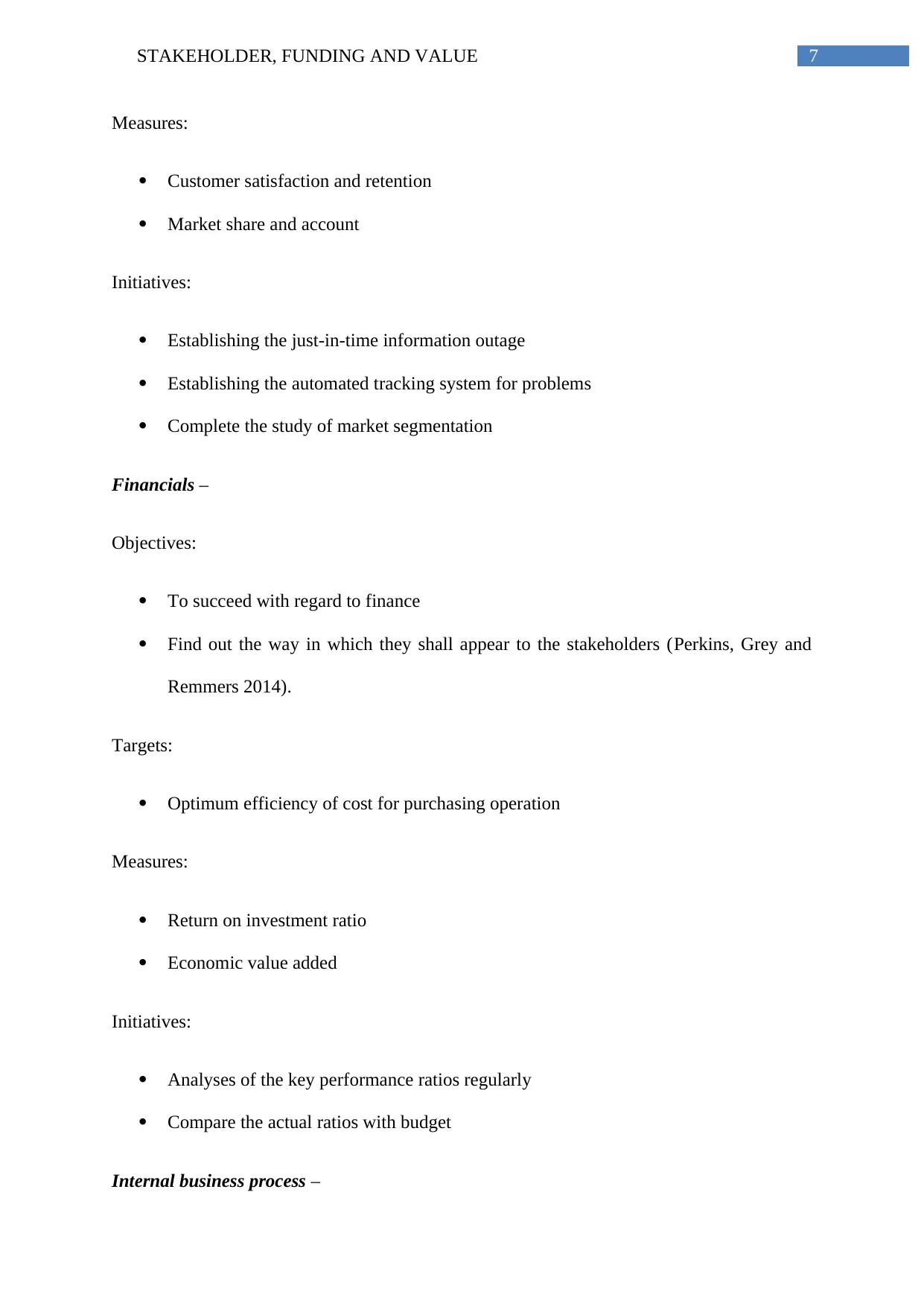
7STAKEHOLDER, FUNDING AND VALUE
Measures:
Customer satisfaction and retention
Market share and account
Initiatives:
Establishing the just-in-time information outage
Establishing the automated tracking system for problems
Complete the study of market segmentation
Financials –
Objectives:
To succeed with regard to finance
Find out the way in which they shall appear to the stakeholders (Perkins, Grey and
Remmers 2014).
Targets:
Optimum efficiency of cost for purchasing operation
Measures:
Return on investment ratio
Economic value added
Initiatives:
Analyses of the key performance ratios regularly
Compare the actual ratios with budget
Internal business process –
Measures:
Customer satisfaction and retention
Market share and account
Initiatives:
Establishing the just-in-time information outage
Establishing the automated tracking system for problems
Complete the study of market segmentation
Financials –
Objectives:
To succeed with regard to finance
Find out the way in which they shall appear to the stakeholders (Perkins, Grey and
Remmers 2014).
Targets:
Optimum efficiency of cost for purchasing operation
Measures:
Return on investment ratio
Economic value added
Initiatives:
Analyses of the key performance ratios regularly
Compare the actual ratios with budget
Internal business process –
Paraphrase This Document
Need a fresh take? Get an instant paraphrase of this document with our AI Paraphraser
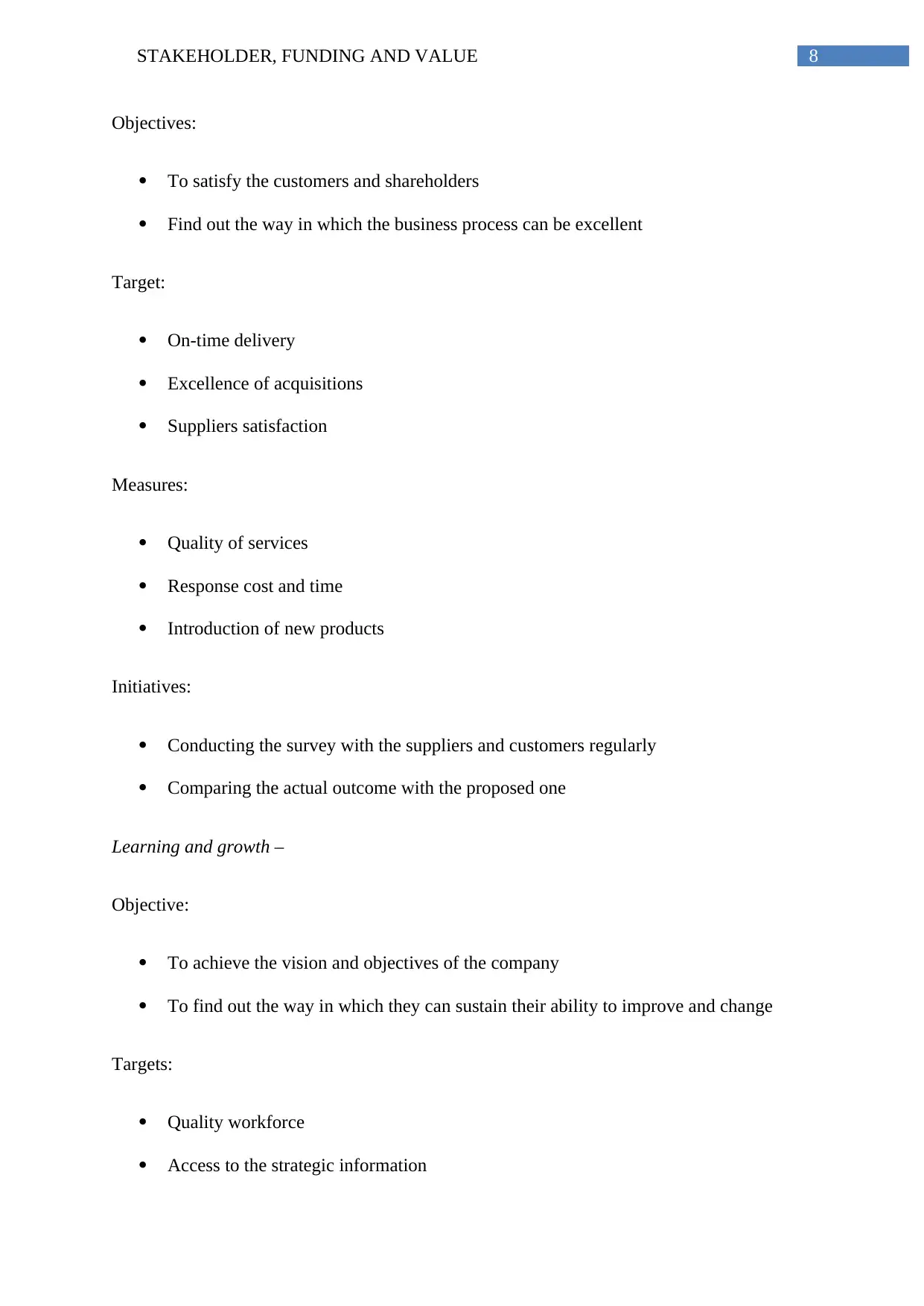
8STAKEHOLDER, FUNDING AND VALUE
Objectives:
To satisfy the customers and shareholders
Find out the way in which the business process can be excellent
Target:
On-time delivery
Excellence of acquisitions
Suppliers satisfaction
Measures:
Quality of services
Response cost and time
Introduction of new products
Initiatives:
Conducting the survey with the suppliers and customers regularly
Comparing the actual outcome with the proposed one
Learning and growth –
Objective:
To achieve the vision and objectives of the company
To find out the way in which they can sustain their ability to improve and change
Targets:
Quality workforce
Access to the strategic information
Objectives:
To satisfy the customers and shareholders
Find out the way in which the business process can be excellent
Target:
On-time delivery
Excellence of acquisitions
Suppliers satisfaction
Measures:
Quality of services
Response cost and time
Introduction of new products
Initiatives:
Conducting the survey with the suppliers and customers regularly
Comparing the actual outcome with the proposed one
Learning and growth –
Objective:
To achieve the vision and objectives of the company
To find out the way in which they can sustain their ability to improve and change
Targets:
Quality workforce
Access to the strategic information
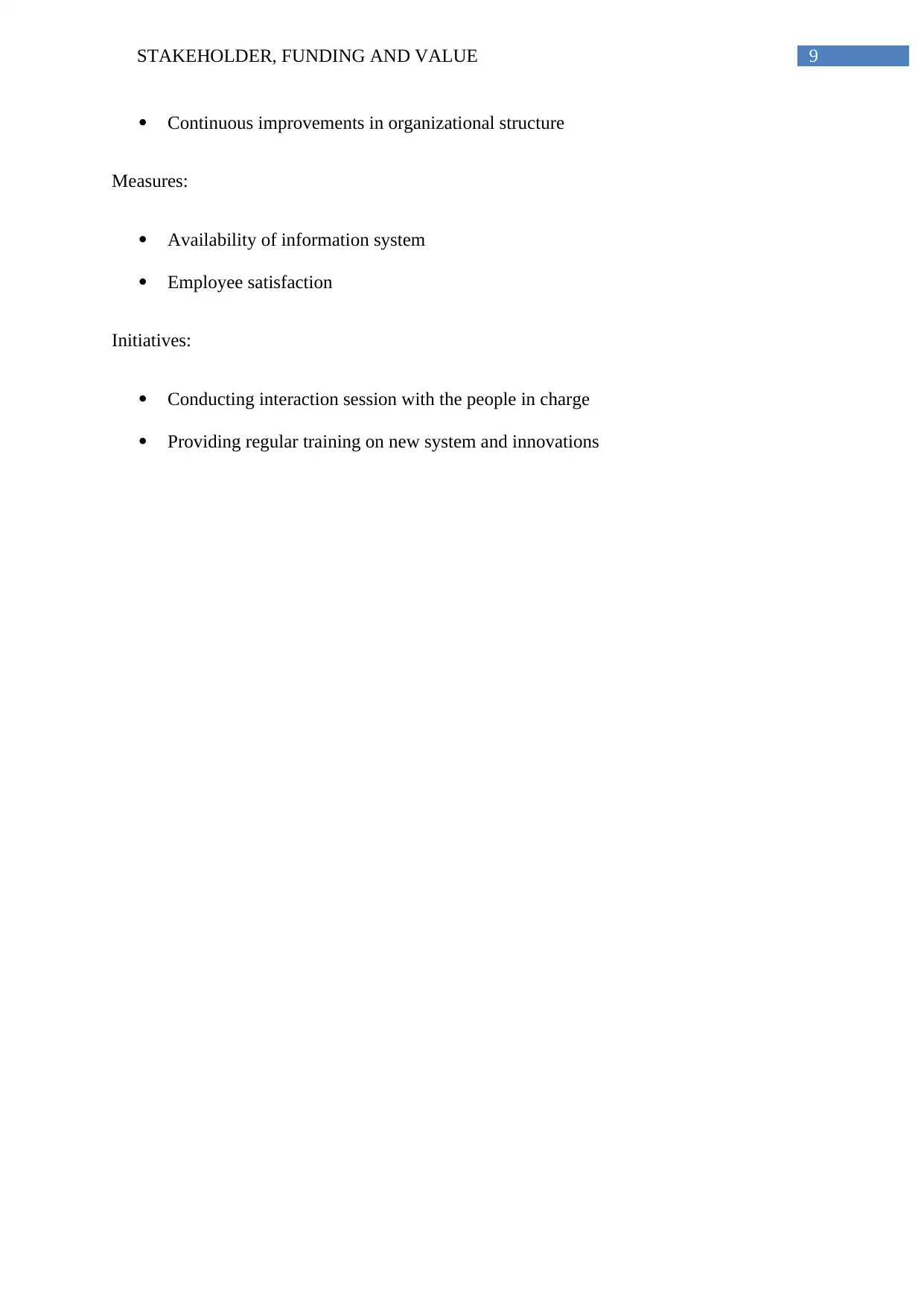
9STAKEHOLDER, FUNDING AND VALUE
Continuous improvements in organizational structure
Measures:
Availability of information system
Employee satisfaction
Initiatives:
Conducting interaction session with the people in charge
Providing regular training on new system and innovations
Continuous improvements in organizational structure
Measures:
Availability of information system
Employee satisfaction
Initiatives:
Conducting interaction session with the people in charge
Providing regular training on new system and innovations
⊘ This is a preview!⊘
Do you want full access?
Subscribe today to unlock all pages.

Trusted by 1+ million students worldwide
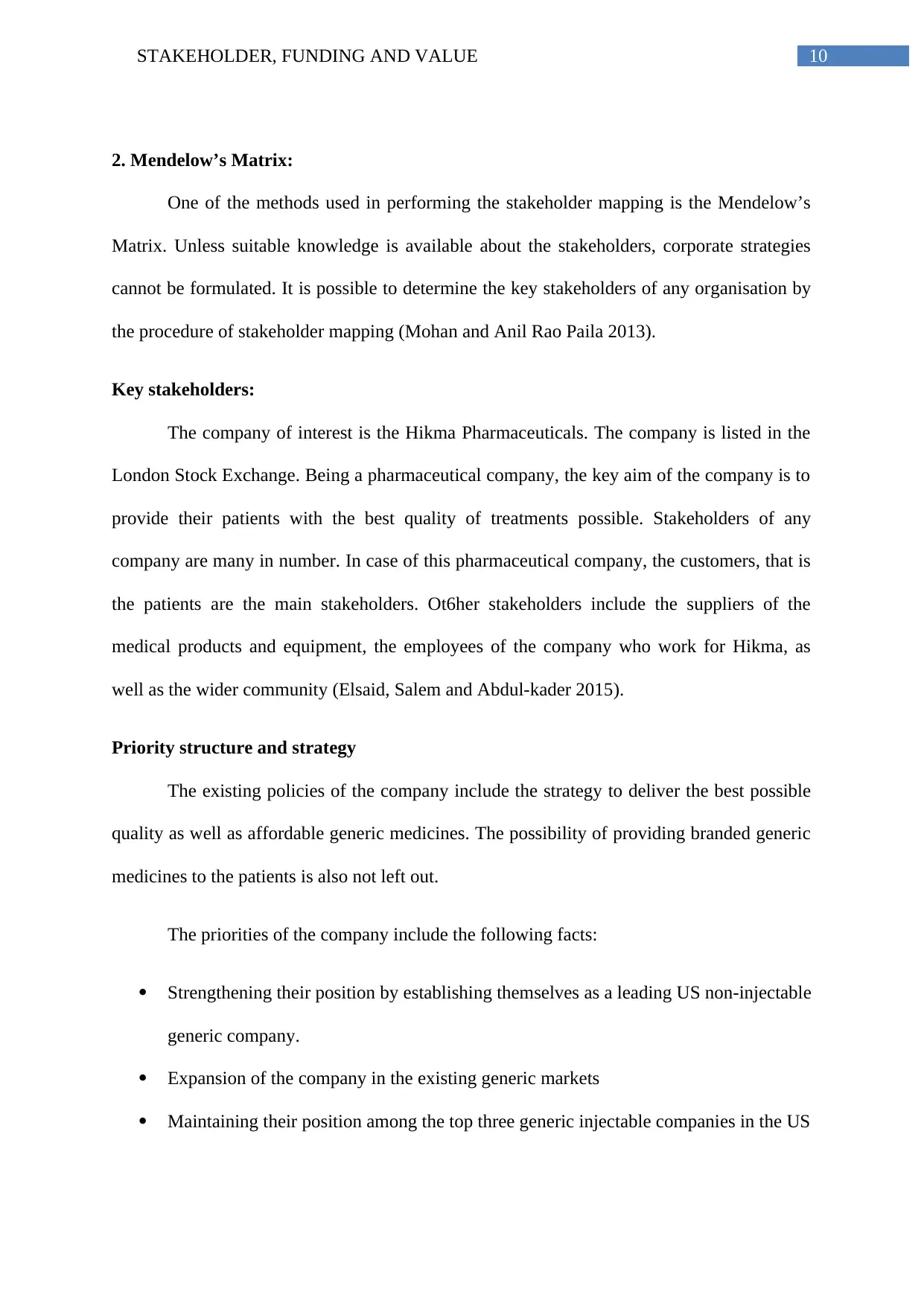
10STAKEHOLDER, FUNDING AND VALUE
2. Mendelow’s Matrix:
One of the methods used in performing the stakeholder mapping is the Mendelow’s
Matrix. Unless suitable knowledge is available about the stakeholders, corporate strategies
cannot be formulated. It is possible to determine the key stakeholders of any organisation by
the procedure of stakeholder mapping (Mohan and Anil Rao Paila 2013).
Key stakeholders:
The company of interest is the Hikma Pharmaceuticals. The company is listed in the
London Stock Exchange. Being a pharmaceutical company, the key aim of the company is to
provide their patients with the best quality of treatments possible. Stakeholders of any
company are many in number. In case of this pharmaceutical company, the customers, that is
the patients are the main stakeholders. Ot6her stakeholders include the suppliers of the
medical products and equipment, the employees of the company who work for Hikma, as
well as the wider community (Elsaid, Salem and Abdul-kader 2015).
Priority structure and strategy
The existing policies of the company include the strategy to deliver the best possible
quality as well as affordable generic medicines. The possibility of providing branded generic
medicines to the patients is also not left out.
The priorities of the company include the following facts:
Strengthening their position by establishing themselves as a leading US non-injectable
generic company.
Expansion of the company in the existing generic markets
Maintaining their position among the top three generic injectable companies in the US
2. Mendelow’s Matrix:
One of the methods used in performing the stakeholder mapping is the Mendelow’s
Matrix. Unless suitable knowledge is available about the stakeholders, corporate strategies
cannot be formulated. It is possible to determine the key stakeholders of any organisation by
the procedure of stakeholder mapping (Mohan and Anil Rao Paila 2013).
Key stakeholders:
The company of interest is the Hikma Pharmaceuticals. The company is listed in the
London Stock Exchange. Being a pharmaceutical company, the key aim of the company is to
provide their patients with the best quality of treatments possible. Stakeholders of any
company are many in number. In case of this pharmaceutical company, the customers, that is
the patients are the main stakeholders. Ot6her stakeholders include the suppliers of the
medical products and equipment, the employees of the company who work for Hikma, as
well as the wider community (Elsaid, Salem and Abdul-kader 2015).
Priority structure and strategy
The existing policies of the company include the strategy to deliver the best possible
quality as well as affordable generic medicines. The possibility of providing branded generic
medicines to the patients is also not left out.
The priorities of the company include the following facts:
Strengthening their position by establishing themselves as a leading US non-injectable
generic company.
Expansion of the company in the existing generic markets
Maintaining their position among the top three generic injectable companies in the US
Paraphrase This Document
Need a fresh take? Get an instant paraphrase of this document with our AI Paraphraser
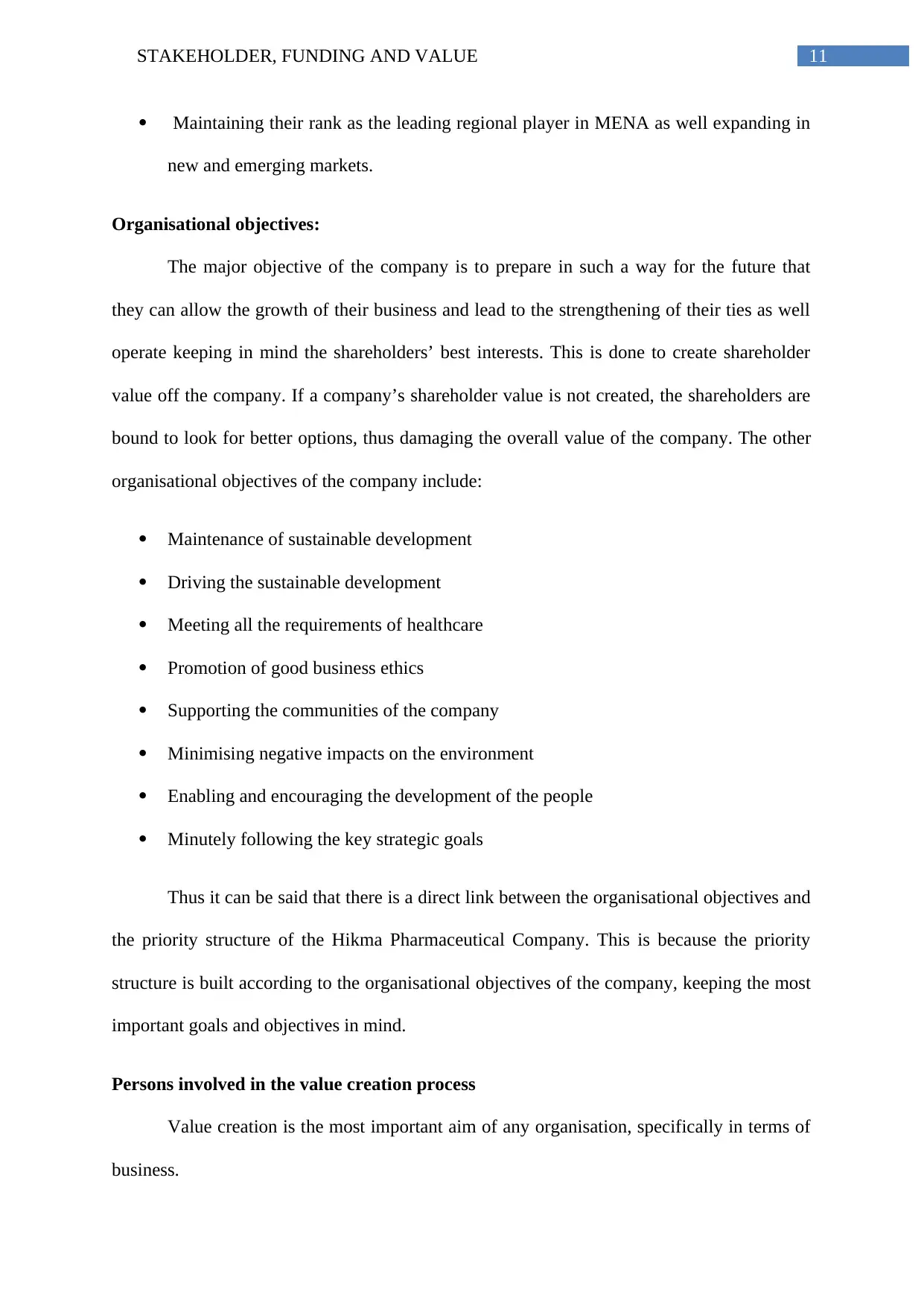
11STAKEHOLDER, FUNDING AND VALUE
Maintaining their rank as the leading regional player in MENA as well expanding in
new and emerging markets.
Organisational objectives:
The major objective of the company is to prepare in such a way for the future that
they can allow the growth of their business and lead to the strengthening of their ties as well
operate keeping in mind the shareholders’ best interests. This is done to create shareholder
value off the company. If a company’s shareholder value is not created, the shareholders are
bound to look for better options, thus damaging the overall value of the company. The other
organisational objectives of the company include:
Maintenance of sustainable development
Driving the sustainable development
Meeting all the requirements of healthcare
Promotion of good business ethics
Supporting the communities of the company
Minimising negative impacts on the environment
Enabling and encouraging the development of the people
Minutely following the key strategic goals
Thus it can be said that there is a direct link between the organisational objectives and
the priority structure of the Hikma Pharmaceutical Company. This is because the priority
structure is built according to the organisational objectives of the company, keeping the most
important goals and objectives in mind.
Persons involved in the value creation process
Value creation is the most important aim of any organisation, specifically in terms of
business.
Maintaining their rank as the leading regional player in MENA as well expanding in
new and emerging markets.
Organisational objectives:
The major objective of the company is to prepare in such a way for the future that
they can allow the growth of their business and lead to the strengthening of their ties as well
operate keeping in mind the shareholders’ best interests. This is done to create shareholder
value off the company. If a company’s shareholder value is not created, the shareholders are
bound to look for better options, thus damaging the overall value of the company. The other
organisational objectives of the company include:
Maintenance of sustainable development
Driving the sustainable development
Meeting all the requirements of healthcare
Promotion of good business ethics
Supporting the communities of the company
Minimising negative impacts on the environment
Enabling and encouraging the development of the people
Minutely following the key strategic goals
Thus it can be said that there is a direct link between the organisational objectives and
the priority structure of the Hikma Pharmaceutical Company. This is because the priority
structure is built according to the organisational objectives of the company, keeping the most
important goals and objectives in mind.
Persons involved in the value creation process
Value creation is the most important aim of any organisation, specifically in terms of
business.
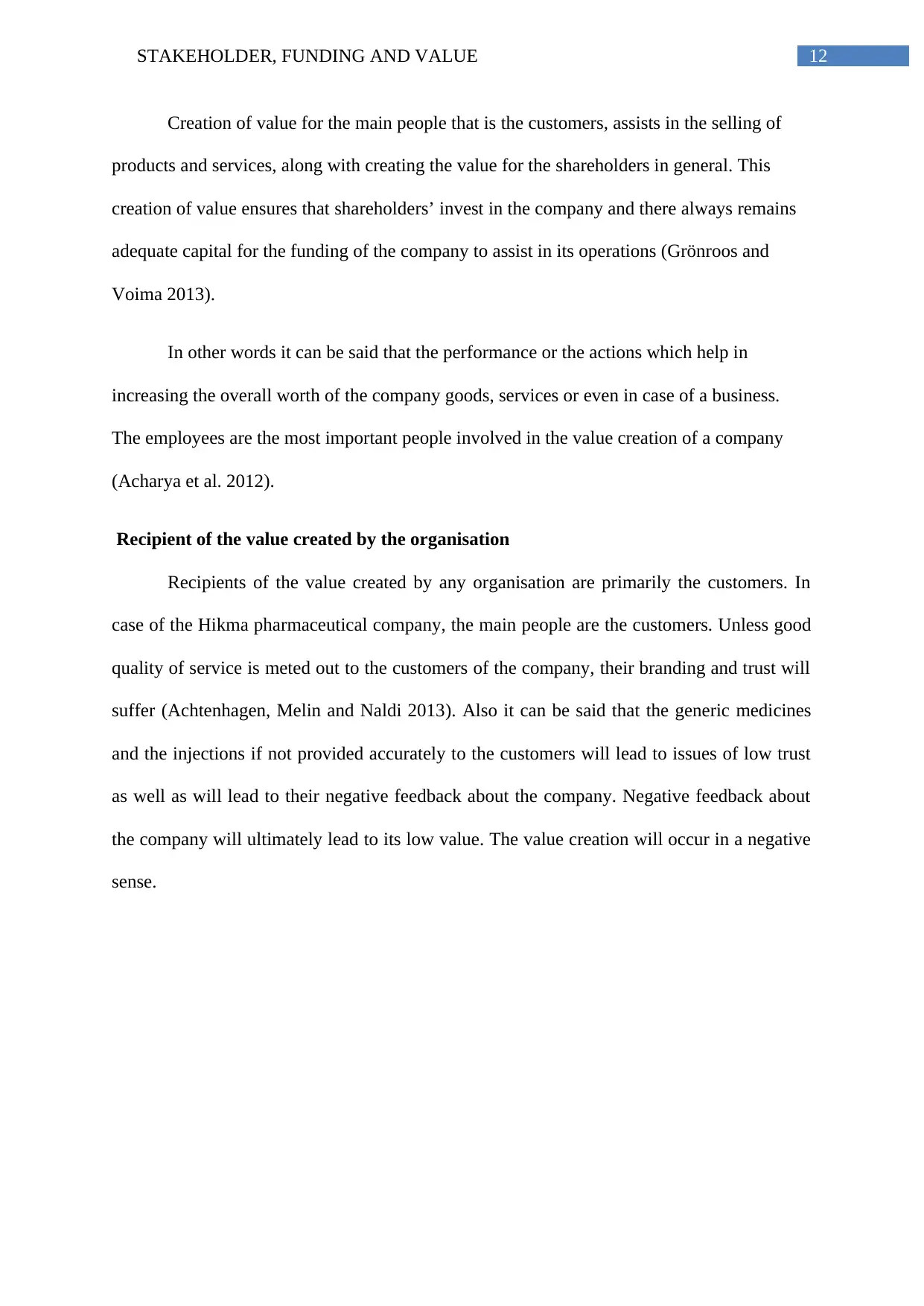
12STAKEHOLDER, FUNDING AND VALUE
Creation of value for the main people that is the customers, assists in the selling of
products and services, along with creating the value for the shareholders in general. This
creation of value ensures that shareholders’ invest in the company and there always remains
adequate capital for the funding of the company to assist in its operations (Grönroos and
Voima 2013).
In other words it can be said that the performance or the actions which help in
increasing the overall worth of the company goods, services or even in case of a business.
The employees are the most important people involved in the value creation of a company
(Acharya et al. 2012).
Recipient of the value created by the organisation
Recipients of the value created by any organisation are primarily the customers. In
case of the Hikma pharmaceutical company, the main people are the customers. Unless good
quality of service is meted out to the customers of the company, their branding and trust will
suffer (Achtenhagen, Melin and Naldi 2013). Also it can be said that the generic medicines
and the injections if not provided accurately to the customers will lead to issues of low trust
as well as will lead to their negative feedback about the company. Negative feedback about
the company will ultimately lead to its low value. The value creation will occur in a negative
sense.
Creation of value for the main people that is the customers, assists in the selling of
products and services, along with creating the value for the shareholders in general. This
creation of value ensures that shareholders’ invest in the company and there always remains
adequate capital for the funding of the company to assist in its operations (Grönroos and
Voima 2013).
In other words it can be said that the performance or the actions which help in
increasing the overall worth of the company goods, services or even in case of a business.
The employees are the most important people involved in the value creation of a company
(Acharya et al. 2012).
Recipient of the value created by the organisation
Recipients of the value created by any organisation are primarily the customers. In
case of the Hikma pharmaceutical company, the main people are the customers. Unless good
quality of service is meted out to the customers of the company, their branding and trust will
suffer (Achtenhagen, Melin and Naldi 2013). Also it can be said that the generic medicines
and the injections if not provided accurately to the customers will lead to issues of low trust
as well as will lead to their negative feedback about the company. Negative feedback about
the company will ultimately lead to its low value. The value creation will occur in a negative
sense.
⊘ This is a preview!⊘
Do you want full access?
Subscribe today to unlock all pages.

Trusted by 1+ million students worldwide
1 out of 20
Related Documents
Your All-in-One AI-Powered Toolkit for Academic Success.
+13062052269
info@desklib.com
Available 24*7 on WhatsApp / Email
![[object Object]](/_next/static/media/star-bottom.7253800d.svg)
Unlock your academic potential
Copyright © 2020–2025 A2Z Services. All Rights Reserved. Developed and managed by ZUCOL.





